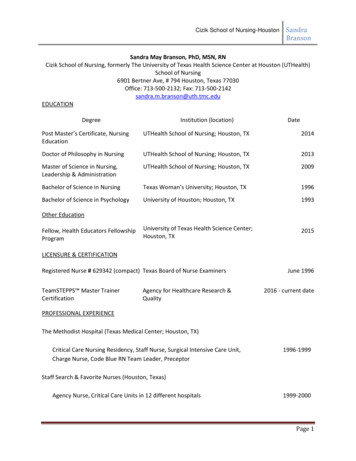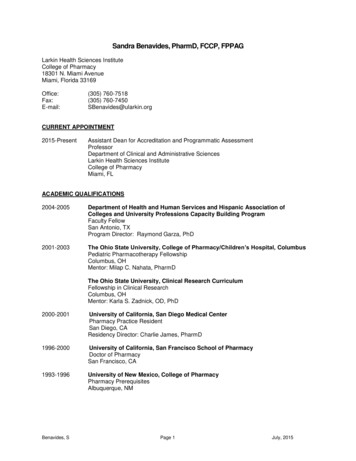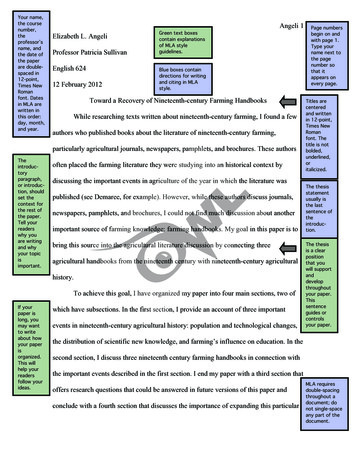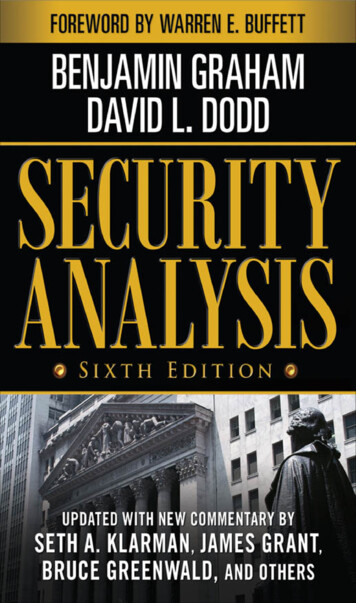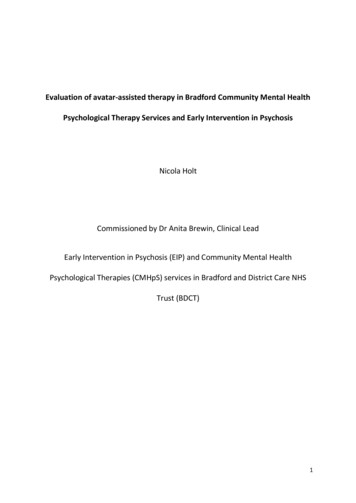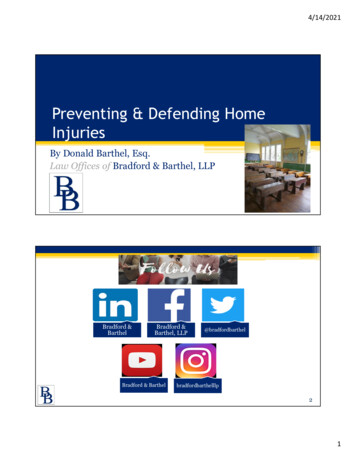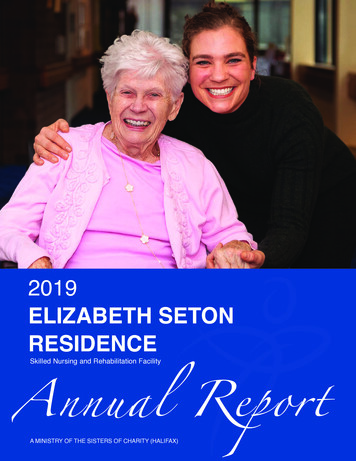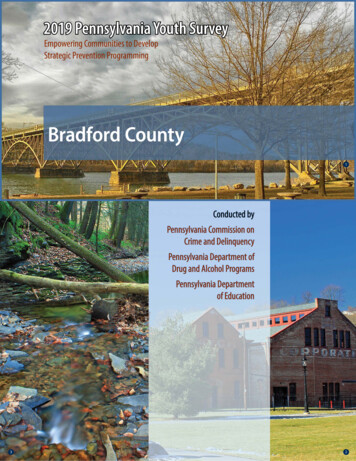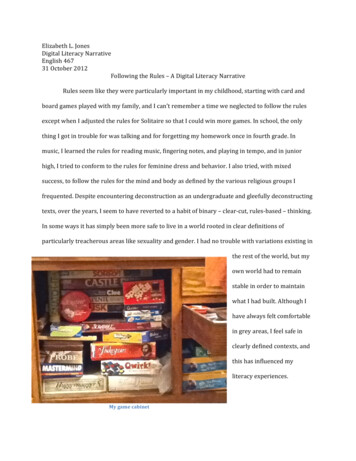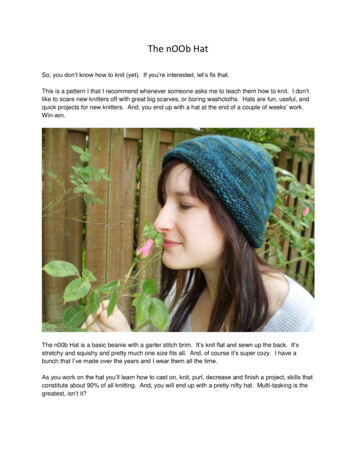
Transcription
MI OPEN BOOK PROJECTMcAnn Bradford, Sandra Freeland, Elizabeth Kastl,Joy Kooyer, Marilyn McCauley, Andrea Raven,Susan Welch
The text of this book is licensed under a Creative CommonsNonCommercial-ShareAlike (CC-BY-NC-SA) license as part ofMichigan’s participation in the national #GoOpen movement.This is version 1.2 of this resource, released inFebruary 2017Information on the latest version and updates are available on the projecthomepage: tion-NonCommercial-ShareAlike CC BY-NC-SA
The Michigan Open BookProjectAbout the Authors - Michigan StudiesMcAnn BradfordKaleva Norman Dickson ElementaryKaleva Normon Dickson SchoolsMcAnn teaches third grade all subjects at KND Elementary in Onekema Michigan.Project Manager: Dave Johnson, WexfordMissaukee Intermediate School District3rd Grade Team Editor: Carol EgboAuthorsMcAnn Bradford, Kaleva Norman DixonJannan Cotto, Little Traverse Bay Band OdawaSandy Freeland, McBain Rural AgriculturalSchoolsElizabeth Kastl, Mesick Consolidated SchoolsJoy Kooyer, Holland Public SchoolsMarilyn McCauley, West BranchDorothy Perry, Little Traverse Bay Band Odawa,Andrea Raven, Ludington Area Public SchoolsAlison Simon, Little Traverse Bay Band OdawJannan CottoLittle Traverse Bay Bands of Odawa IndiansEducation DepartmentAn advocate of social and eco-justice, Jannan Cotto, Education Director for the Little Traverse Bay Bands of Odawa Indians, has worked in Indigenous Education for 9 years in bothurban and reservation communities with the goal of contributing to the educational sovereignty, healing, and well-being of Indigenous people. She graduated from Northeastern Illinois University with a degree in inter-disciplinary studies with an emphasis in English andEducation and a minor in Psychology. She is currently studying in an online Master’s program at Eastern Michigan University studying Social Foundations of Education with a concentration in eco-justice. She serves as the current Chair of the Confederation of MichiganTribal Education Directors and serves on the Board of Regents for Bay Mills CommunityCollege. One of the focuses of her work includes developing Indigenous land-based education for both Indigenous and non-Indigenous learners that emphasizes Indigenous perspectives, encourages relationships with land, and inspires critical thinking and critical action inour global community. She is currently working on curriculum development through part-Sandy FreelandMcBain Elementary SchoolMcBain Rural Agricultural SchoolSandy is a full time teacher at McBain Elementary School in McBain Michigan. She hastaught Kindergarten and Third Grade during her time there. In addition to classroom teaching she’s also provided technology professional development for the district. Outside of theschool day she can be found learning from others in Twitter chats, participating in groupsonfFacebook, and working on developing a coding club for her school.
Beth KastlFloyd M. Jewett Elementary SchoolMesick Consolidated SchoolsBeth is an elementary teacher from Floyd M. Jewett Elementary school, where she hasworked in a variety of grade levels including first and third grade.Joy KooyerWest K-7Holland Public SchoolsJoy received her Bachelor of Science degree from Southern Wesleyan University in EarlyChildhood Education and her Master’s degree in the Art of Teaching from Marygrove College. She has always taught third grade and thinks it the best grade ever. She is the chairperson for the National Geographic Bee. Joy has been Holland Sentinel’s Teacher Of TheYear and been chosen for WGVU’s, “Cool Teacher” award. She enjoys traveling. Her goalis to see all of the 50 state capitals and visit all of the MLB parks. Joy finds great pleasurein reading, scrapbooking and spending time with her husband, Jason and three children,Julia,12 Harrison, 9 and Jameson, 2.Marilyn McCauleySurline ElementaryWest Branch Rose City SchoolsAfter attending a wonderful 2 year experience with the amazing professors at KirtlandCommunity College, I continued to work toward a Bachelors of Science Degree with thewonderful professors at Central Michigan University, also obtaining a teaching certificate.My focused subjects at CMU were language arts and social studies. Michigan State University, with its outstanding professionals, is where I enjoyed working for my Masters Degree in Education. Learning is a continuous journey I treasure through our expert COORDistrict and Surline Elementary instructors. I also enjoy independent studies I have done
Dorothy PerryAcademic Services CoordinatorLittle Traverse Bay Bands of Odawa IndiansComing from a long line of Educators, Dorothy Perry has continued to follow in this directionwith passion and commitment. The culmination of 25 years in the field of Education includes, Early Childhood Education with a focus on the whole child through self-led discovery and learning. Continuing as a Family/School Liaison and supporting parents with infant/toddler development. For the past 14 years, Dorothy has concentrated on building Indigenous Education programs for youth and community, including developing Land-based cur-Andrea RavenFoster Elementary SchoolLudington Area Public SchoolsAndrea Raven currently teaches 3rd grade at Foster Elementary in Ludington, Michigan.She earned a Bachelor of Arts Degree in Elementary Education and Spanish from AlbionCollege. While at Albion, she studied abroad in Spain. It was a positive experience thatallowed her to immerse in the culture and education system. She is completing her seventh year of teaching and has taught both 5th and 3rd grades. Andrea serves as the Social Studies Department Chair at her school. She has earned her Master’s Degree in Curriculum Instruction from Grand Valley State University. Outside of the education world,Alison SimonCurriculum Specialist/Grant WriterLittle Traverse Bay Band of Odawa IndiansBiography Forthcoming!
Susan WelchFenton Area Public SchoolsState Road ElementarySusan Welch currently teaches 4th grade at State Road Elementary in Fenton, Michigan. She has earned aBachelor of Science Degree in Elementary Education from Central Michigan University and a Master’s Degree in the Art of Teaching from Marygrove College with additional graduate work done at Arizona StateUniversity. While at CMU, Susan traveled to Perth in Western Australia to study their use of integration todeliver instruction and meet the curriculum standards. Upon graduation, she started her teaching career inArizona teaching in the Casa Grande and Kyrene school districts. During this time, Susan taught in a fullyinclusive elementary classroom with students with many diverse learning needs including monolingual andbilingual Spanish speaking students, as well as various physical and mental challenges. She also was ableto learn about the many different Native American cultures represented within her schools. Susan hastaught both 3rd and 4th grade in the Fenton Area Public Schools for the past 11 years and also serves asCarol Bacak-EgboEditorCarol Egbo has more than 40 years of experience in education as a teacher, curriculum developer, staff development specialist, and social studies consultant. She is currently a special lecturer in the Teacher Development and Educational Studies Department at OaklandUniversity, and a contract consultant for the Oakland Intermediate School District. She hasbeen project director for two federal Teaching American History Grants, and was the primary curriculum designer and writer for grades 2-6 of the Michigan Citizenship Collaborative Curriculum (MC3) Project. She has extensive experience in presenting professional development for teachers including summer institutes at University of California-Los Angeles,institutes for the Michigan Department of Education, teacher networks, national and stateconferences, teacher seminars sponsored by Michigan State University, Saginaw ValleyState University, and Oakland University. She is the recipient of numerous awards includingCarol GersmehlCartographic ConsultantCarol Gersmehl is a map maker and teacher trainer. She worked in a census-data researchoffice, then taught cartography and Geographic Information Systems for 17 years at Macalester College in St. Paul, Minnesota. In 2005, she became co-director of the New YorkCenter for Geographic Learning and co-coordinator of the New York Geographic Alliance.While in New York, she also taught Advanced Placement World Geography and helpedadvise teachers at a K-12 school in Queens. She still flies back occasionally to work withschools in New York, but now she is cartographic advisor, educational materials author,and teacher-trainer for the Michigan Geographic Alliance.
Chapter 4How did the Movementof People Impact theEarly History ofMichigan?1. In what ways have the people of Michiganinteracted with their environment?2. What push and pull factors influenced themovement of people in Early Michigan History?3. What consequences resulted from theinteractions between various cultural groups?
Section 1How Do Historians Study the Past?QUESTIONS TO GUIDE INQUIRYYou have learned that there are different areas of social studies. You1. In what ways have the people of Michiganinteracted with their environment?have learned about geography. You have also learned about2. What push and pull factors influenced themovement of people in Early MichiganHistory?discover that history is what happened in the past.economics. In this chapter you will learn about history. You will3. What consequences resulted from theinteractions between various culturalgroups?TERMS, PLACES, PEOPLEhistory: what happened in the pasthistorian: a person who studies the pastWork with a partner and make a list of words that come tomind when you think of the word “history”historical sources: things that tell us about thepastprimary sources: records made by people whosaw or took place in an eventsecondary sources: records written by someonewho was not there at the time115
What Do Historians Do?In chapter one you learned that geographers ask lotsare things like photographs, diaries and old letters.They can be objects like old toys.of questions when they study aplace! Some of these questionswere: Where is the place?Think about your own past. What historical sources could ahistorian use to learn about your past? What is it like there? How do people use places? How is a place connected to other places?In this chapter you’ll discover that historians ask a lotof questions too. Geographers ask questions aboutplaces. Historians ask questions about the past.You learned that geographers use tools to studyplaces. They use tools like maps, globes and satelliteimages. Historians use historical sources to study thepast. These are things that tell us about the past. They116
What Kinds of Questions Do Historians Ask?MEET A MICHIGAN HISTORIAN: Eric HemenwayAanii (Hello). My name is Eric Hemenway and Iam the Director of Archives and Records forOne of the most important questions ahistorian asks about the past is: Whatthe Little Traverse Bay Bands of Odawahappened? But is it enough to only knowIndians. All my life I have studied history bywhat happened? Not for a historian!listening to others, visiting areas that tellstories and lots of reading. In my job, I am veryHistorians also want to know why thingslucky to collect important pieces of history forhappened. Imagine a historian is studyingthe Odawa tribe. These pieces of history couldbe photos, letters, books, peoples’ stories,the history of a small town. In a historical source sheartifacts or important documents. Not only do Ifinds out there was a serious fire one hundred yearscollect these parts of history, I use them to teach others about my people,the Anishnaabek. The more we know about the people we live with, theago. It destroyed many of the town buildings. Was thebetter we will get along!fire caused by lightning? Did a person start the fire?History is everywhere and everyone has a history of their own. It’sThe historian will try to find out why the fire happened.important to know what happened to a place, a people or theenvironment. Sometimes bad things happen in history and we don’t wantthat to happen again. Sometimes good things happen in history and wewant to remember that too!Historians also ask: When did it happen? In theexample you just read the fire happened one hundredyears ago. As you study Michigan history in thischapter it will be important to think about when thingshappened. There is still one more question. What’smissing? Let’s review. Historians ask: Whathappened? Why did it happen? When did it happen?But, what about the people? Who were the people117
involved? In our example a historian might try to findout if any people were injured or killed in the fire.Interactive 4.1 QuestionsHistorians AskYou have probably figured out by now that historiansare like detectives. They want to know what, why,when and who! You’ll be working like a historian anddetective in this chapter. You’ll be asking thesequestions about Michigan history.Read the story in this widget andwork like a historian to determinewhat happened, why, when, andto who.Make a chart like the one below on a separate sheet ofpaper. Then, click on the widget to practice yourhistorian skills!The Michigan Historical Center in Lansing, MichiganSource: 00.html118
What Kinds of Historical Sources Do HistoriansUse?Historians answer the questions of history by studyinghistorical sources. These are things that tell us aboutthe past. Here is an historical source. What kind ofhistorical source is it?Both historical sources are about a family beingtrapped in their log cabin. The diary was written aboutthe event in the past. Historians call this kind ofsource a primary source. A primary source is arecord made by people who saw or took place in anevent. The story about the family is a different kind ofsource. It is called a secondary source. A secondarysource is a record written by someone who was notthere at the time.Your probably guessed that this is a page from a diary.How is it different from this next historical source:Imagine that someone in the Washington family wrotea letter describing the blizzard. Would that be aprimary source or a secondary source? Since it was119
written by someone who took place in the event itthe past. There are two kinds of historical sources.would be a primary source.Primary sources are records made by people who sawImagine that you do adrawing of what you thinkInteractive 4.2 PrimarySourcesor took place in an event. Photographs and diaries areprimary sources. Secondary sources are recordswritten by someone who was not there at the time. Athe Washington’s logstory written today about an event in the past is acabin looked like. Would itsecondary source.be a primary source or asecondary source? Sinceyou were not there to seethe real cabin it would beClick here to learn more aboutprimary and secondary sourcesa secondary source.Writing Assignment: Find a partner. Eachof you should write a short story like the one youread about the family getting trapped in their logcabin. Make sure to have a what, why, when andPUTTING IT ALL TOGETHERwho. Then, trade stories and see if you can answerthe questions about each other’s story.History is what happened in the past. Historians studythe past! They study the past by asking questions.These questions are: What happened? Why did ithappen? When did it happen? Who was involved? Toanswer the questions historians study historicalsources. Historical sources are things that tell us about120
Section 2Indigenous People: Then and NowQUESTIONS TO GUIDE INQUIRYIn the last section you learned about history and historians. When1. In what ways have the people of Michiganinteracted with their environment?historians study the history of a place they try to learn about the2. What push and pull factors influenced themovement of people in Early MichiganHistory?people who lived in the place. We call the first people in a placepeople who lived there. They often start by learning about the firstIndigenous. They are the first people to live in a certain area. These3. What consequences resulted from theinteractions between various culturalgroups?people have special connections and rights to that place. In ourTERMS, PLACES, PEOPLEsometimes called Native AmericansIndigenous People: The first people in a place.or American Indians. All three termsAnishinaabek: Some of the first people of theGreat Lakes regionrefer to the ‘first people.’ In thistraditional story: Important stories that arepassed down through timecountry Indigenous People aresection you will learn aboutMichigan’s Indigenous People.migration: people on the moveartifacts: objects from the pastarchaeologist: a special historian who studiesartifacts of the pastWork with a partner and make a list of some of the questionshistorians ask when they study the past.culture: the way of life for a group of peoplereservation: land set aside for IndigenousPeople121
The AnishinaabekTraditional StoriesMost Indigenous People living in Michigan areYou have learned that historians use historical sourcesAnishinaabek. They were some of the very first peopleto study the past. You learned that diaries, old mapsin the Great Lakes region. They call this placeand textbooks are all historical sources. TraditionalAnishinaabe Aki. It means Land of the Anishinaabek.stories are another type of historical source.Michigan is part of Anishinaabe Aki. . They have livedTraditional stories are stories that are passed downin the Great Lakes Region, including Michigan, for athrough time. They show the history, knowledge andlong, long time. The Anishinaabek have special tiesbeliefs of a group of people.and rights to this land we call Michigan.The Anishinaabek belong todifferent tribal groupsInteractive 4.3 OhnekanusNibiTraditional stories have always been very important toIndigenous People such as the Anishinaabek. Thesestories teach the Anishinaabek many different things.including the Odawa, theThey teach them how to live. The also teach themPotawatomi and the Ojibwe.about the world around us. Some stories teach rightThey speak a languagefrom wrong. Others teach how land features came tocalled Anishinaabemowin. Tobe.learn about the Anishinaabekand their history it isimportant to study theirtraditional stories.Click here to hear a song inAnishinaabemowin. The song waswritten by some Anishinaabekchildren in Wisconsin. The song isabout spring and the rain and thepride they have in their kanus-nibi-water/The stories are all unique. They always teach a lessonand tell about the history of an area. The land is veryimportant in Anishinaabek traditional stories. For122
example, a traditional story might tell about a specialNanaboozhoo sometimes plays tricks on people andhill or lake.animals. His stories teach lessons. These stories arecalled Trickster Stories.NanaboozhooThe Anishinaabek believe Nanaboozhoo was sent toteach them how to live. He taught right from wrongthrough his adventures. He offered lessons on how tolive in harmony with the natural world. Nanaboozhoowas a trickster. He could change into different shapesand personalities. He was half spirit and half human.He had some of the same good points and some ofthe bad points that people have. Nanaboozhoo couldTraditional stories are connected to the land and water of a ojibwa-indians.htmlbe selfish or generous. He could be caring or mean.He was always curious and mischievous.According to the Anishinaabek there are special waysIn 2014 the Royal Mint of Canada created a series ofto tell a special story. Some traditional stories can onlycoins honoring the stories of Nanaboozhoo. They werebe told in winter. Some can only be told with specialdesigned by Ojibwe artist Cy
gree in the Art of Teaching from Marygrove College with additional graduate work done at Arizona State University. While at CMU, Susan traveled to Perth in Western Australia to study their use of integration to deliver instruction and meet the curriculum stand
